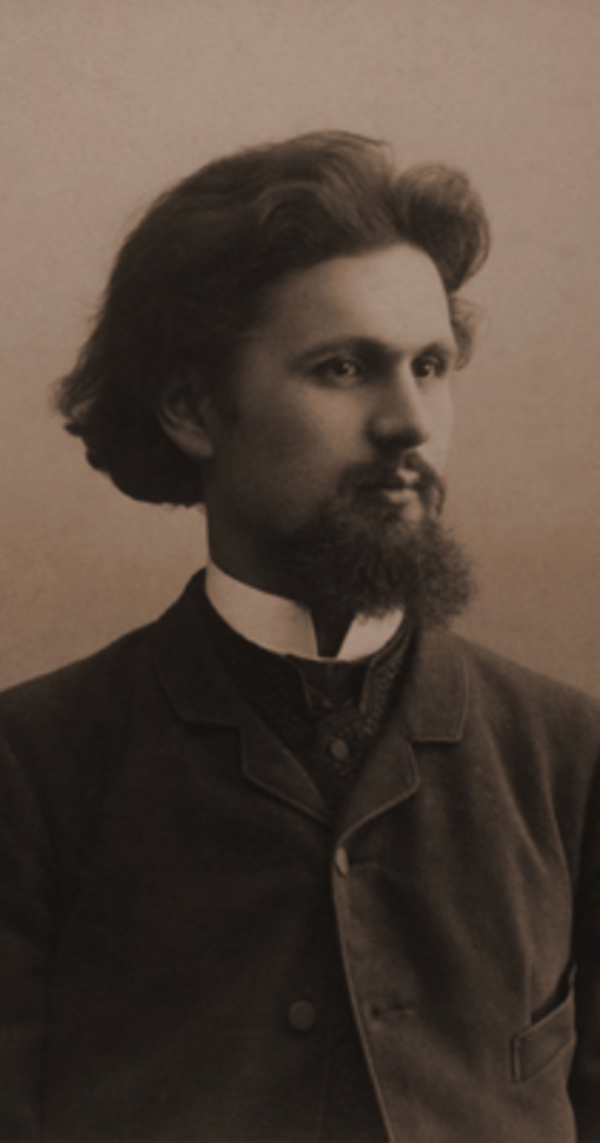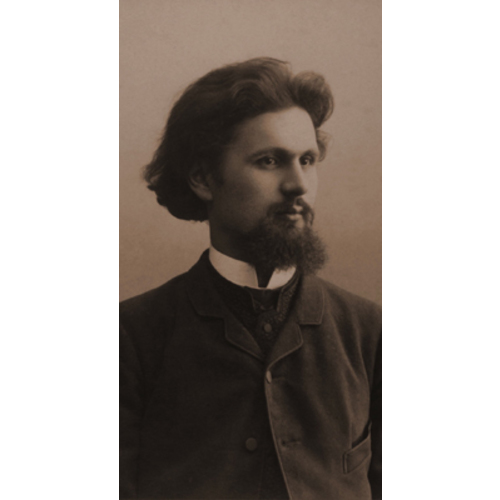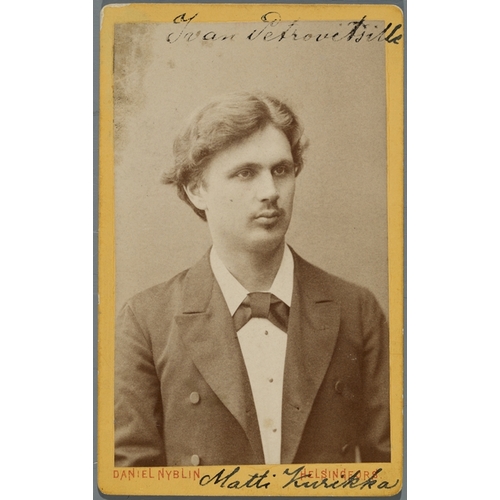
Source: Courtesy of Wikimedia Commons
KURIKKA, MATTI, colonizer, journalist, and publicist; b. 24 Jan. 1863 in the parish of Tuutari, Russia, one of the four children of Aatami Kurikka, a wealthy Finnish farm-owner, and Anna Pöyhönen; m. first 12 Jan. 1886 Anna Henriette Palmqvist in Helsinki (Finland), and they had one daughter; divorced 1898; m. there secondly 23 May 1906 Hanna Räihä, and they had one daughter; divorced 1911; d. 1 Oct. 1915 in Westerly, R.I.
From a bourgeois home, Matti Kurikka attended school in his native region of Ingermanland for three years before moving with his parents to Helsinki in 1872. In 1881 he entered the University of Helsinki but he left for Kuopio without graduating. There he associated with Minna Canth, playwright, socialist, and women’s rights advocate. He also made friends with novelist Arvid Järnefelt and socialist Augusti Bernhard Mäkelä and in 1884 wrote his first notable play, Viimeinen ponnistus [Last effort], on the theme of class conflict.
Throughout his life Kurikka’s struggle for social reform would be influenced by utopian socialism, the anti-clerical humanitarianism of Tolstoy, and theosophy. Despite his rejection of Marxism, he soon became an acknowledged leader in Finnish socialist and radical circles. He capped his rise to prominence in 1897 with the editorship of the labour movement’s leading newspaper Työmies [Worker] in Helsinki. In the face of opposition from Marxists, however, he resigned in April 1899.
This conflict, combined with a step up in the Russification campaign in Finland by Emperor Nicholas II, prompted Kurikka to migrate with a number of other like-minded Finns to Queensland (Australia) with the intent of establishing a colony of working people. It failed, and within the year he was at loose ends. At this juncture a group of Finnish Canadian coalminers near Nanaimo, B.C., wrote to Kurikka asking him to come to the province and start a colony. Towards the end of August 1900 he arrived in Nanaimo, where he assumed the presidency of a colonization company called Kalevan Kansa (People of Kaleva). Malcolm Island, about 200 miles north of Vancouver, was chosen as the location of the colony, which was named Sointula, meaning “harmony.” Late in 1901 the first settlers began to arrive on the island and a printing-press was brought in for a newspaper, Aika [Time]. All the colonists were Finnish, most were young – in their twenties and thirties – and men outnumbered women by at least two to one. Kurikka’s goal was to establish a society where all members would play an active part in the management of their own lives and cooperate fully with others in economic and social matters. In these harmonious surroundings everyone would be free from the sense of alienation and exploitation that characterized modern times. Both Kurikka and his friend Mäkelä, who joined him from Finland in 1901 (and would sometimes be known in Canada as Austin McKela), held out the prospect of “many Sointulas.” The colony operated from the outset under socialist and communitarian principles, and is one of the few examples, other than the Doukhobor colonies, of such settlements in Canada.
Using the public platform through extensive trips across the United States and Canada, as well as the pages of Aika, Kurikka propounded his advanced views. He opposed church-sanctioned marriage as a form of slavery for women. They should not feel bound to one man for life, he asserted, and should experience motherhood without the necessity of a wedding ceremony. Children should be raised by experts, and so a nursery was constructed at the colony where mothers could leave their children while working. The breakup of Sointula in 1904 resulted in part from a bitter debate over free love and marriage. Kurikka insisted on forcing the issue, over objections from the pragmatic Mäkelä who considered the colony’s economic difficulties of much more pressing importance. Agriculture was impossible and neither logging nor fishing had proved profitable. The sawmill had held some promise for a time, but ill-conceived contracts resulted in disastrous losses. The population, which had numbered 238 in 1903, was severely depleted by the departure of Kurikka and half the members in October 1904. The colonization company was liquidated on 27 May 1905. Mäkelä placed blame on the extreme idealists such as Kurikka, “people who tried to make the stumps lay eggs,” and “had lots of talent when it came to talking about wonderful ideas, but left their realization to others.”
Meanwhile Kurikka made one more attempt to found a utopian settlement, in the Fraser valley some 30 miles east of Vancouver. A new colonization company called Sammon Takojat was formed in 1904 with him as secretary. Within months this experiment too failed and in September 1905 Kurikka, disheartened, returned to Finland. But like many migrants he encountered great difficulty in reintegrating into his native society, and he went to the United States in 1908. He became a columnist for, and later co-editor of, the New Yorkin Uutiset [New York News], and in 1913 bought a farm in Westerly, R.I. His death came suddenly of heart failure in 1915.
Kurikka left a lasting legacy among Finnish Canadian socialists, who became adherents of early Canadian left-wing parties in disproportionately large numbers and who invoke his name to this day. A Finnish tone, though muted, still survives at Malcolm Island and at Webster Corners, site of Sammon Takojat. But in a minor way Kurikka was also part of the larger history of Canada, in the sense that his activities coincided with the general spread of socialism and the questioning of industrial capitalism during the first two decades of the 20th century.
J. I. Kolehmainen, “Harmony Island: a Finnish utopian venture in British Columbia,” British Columbia Hist. Quarterly (Victoria), 5 (1941): 111–23. P. C. Miller, “A British Columbian fishing village”
Cite This Article
J. Donald Wilson, “KURIKKA, MATTI,” in Dictionary of Canadian Biography, vol. 14, University of Toronto/Université Laval, 2003–, accessed November 28, 2024, http://www.biographi.ca/en/bio/kurikka_matti_14E.html.
The citation above shows the format for footnotes and endnotes according to the Chicago manual of style (16th edition). Information to be used in other citation formats:
| Permalink: | http://www.biographi.ca/en/bio/kurikka_matti_14E.html |
| Author of Article: | J. Donald Wilson |
| Title of Article: | KURIKKA, MATTI |
| Publication Name: | Dictionary of Canadian Biography, vol. 14 |
| Publisher: | University of Toronto/Université Laval |
| Year of publication: | 1998 |
| Year of revision: | 1998 |
| Access Date: | November 28, 2024 |





